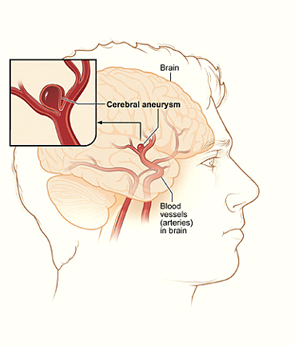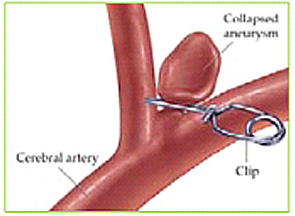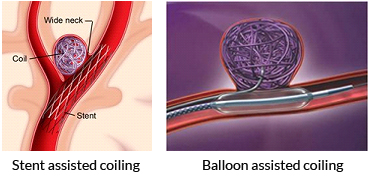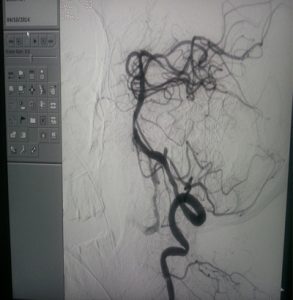BRAIN ANEURYSM
- Brain Aneurysm
- Case Studies
- Videos
- Testimonials
 A brain aneurysm is a weak, bulging spot on the side of a brain artery very much like a thin balloon. Saccular or “berry” aneurysms are the most common type of brain aneurysm. Fusiform aneurysm are less common and are defined by widening of brain artery on both sides. They do not have a defined neck.
A brain aneurysm is a weak, bulging spot on the side of a brain artery very much like a thin balloon. Saccular or “berry” aneurysms are the most common type of brain aneurysm. Fusiform aneurysm are less common and are defined by widening of brain artery on both sides. They do not have a defined neck.

Aneurysms which have bled are called ruptured aneurysms. When the aneurysm ruptures, the blood from the aneurysm usually goes into subarachnoid space , this type of bleed is called a subarachnoid hemorrhage. Rupture of an aneurysm usually causes a sudden severe headache described as the “worst headache of your life”. Other signs of subarachnoid hemorrhage are severe nausea and vomiting, stiff neck and even loss of consciousness.
Unruptured aneurysms may be found by chance on tests performed for other problems such as headaches On occasion, unruptured aneurysms may grow large and press on brain nerves causing problems such as double vision, drooping eyelid, or pain behind the eye. Rarely do unruptured aneurysms cause chronic headaches.
When a ruptured brain aneurysm is suspected, a CT scan is done on an emergency basis. This is the standard test to detect bleeding in the brain. The bleeding can be localized and graded according to its severity. Locating the bleed can also help in estimating the location of the ruptured aneurysm. A CTA or MRA maybe done to diagnose aneurysm but sometimes an angiogram (arteriogram) is needed to better see the aneurysm neck and morphology


.DSA: ( Digital Subtraction Angiogram ):This is the gold standard test for detecting brain aneurysms. It is done in a Cath-Lab. During this test, a catheter is navigated into the arteries supplying the brain and contrast is injected. This can be seen under X rays and accurate pictures of the aneurysms can be taken. This helps not only in localising the aneurysm but also gives us valuable information regarding its morphology, its angulation, orientation of the aneyurysm neck and helps in deciding the “working angle” . This is the angle of the X ray beam that best shows the neck of the aneurysm and would be best to treat the aneurysm.
Surgical Clipping: This is an open surgery in which the brain is surgically accessed and a clip is placed across the neck of the aneurysm, thus preventing it from filling. As this is an open surgery, morbidity related to surgical brain injury can occur. Also, recovery period can be longer.
Endovascular Coiling: This is a minimally invasive treatment of brain aneurysm. The procedure is carried out from the femoral artery that is accessed from the groin, as for the angiogram. Tiny detachable platinum coils are navigated up the brain arteries and to the aneurysm. These are then positioned within the aneurysm. Multiple such coils are placed so that the aneurysm is completely filled.Currently, almost all types of aneurysms, regardless of the width of its neck can be treated by endovascular
coiling.Newer methods like Balloon Assisted and Stent assisted coiling are used to treat aneurysms with wide necks which would otherwise need open surgeryRecent advances like the Flow Diverter Device, which is a pipeline that redirects blood flow away from the aneurysm are available to treat giant, fusiform and very wide necked aneurysms. 

Subarachnoid haemorrhage causes normal cerebral arteries to come in contact with blood. This causes cerebral vasospasm. This means the blood vessels of the brain contract and become narrow. This can be prevented by giving the “HHH” therapy, which included Hypertension, Hemodilution and Hypervolemia. This therapy is initiated as soon as the aneurysm is secured so as to prevent the arteries from going into spasm. This is most common during the 5th to 10th days after first onset of bleeding. If vasospasm does occur, it is treated by giving an oral and or intra-arterial injection of Nimodipine, this is a vasodilator and is injected via a catheter in the brain arteries ( done in the Cath-Lab).
Aneurysm coiling is a relatively safe procedure, and is as effective as surgical clipping in terms of regrowth of the aneurysm.Results of coiling are better than surgical clippingISAT Trial (International subarachnoid Aneurysm trial)
Randomized, prospective, international controlled trial compared neurosurgical clipping with endovascular treatment in aneurysms and concluded that results of coiling were better than surgical clipping.
The early survival advantage was maintained for up to 7 years and was significant.
BRAT Trial (The Barrow Ruptured Aneurysm Trial)
Endovascular coil embolization is superior to microsurgical clipping
Case 1 – Coiling of LEFT PICA aneurysm missed on first DSA
55 years old lady presented with severe worst headache. Ct brain showed diffuse SAH. Her first DSA done at Mumbai was normal. Repeat DSA after 3 weeks showed a small left PICA/VA junction aneurysm. The aneurysm was coiled and pt made complete recovery.
Case 2 – Coiling of multiple aneurysms
48 year gentleman presented with severe headache, left hemiparesis.CT brain showed SAH. Cerebral angiography (DSA) showed 2 MCA bifurcation aneurysms. Post coiling of both aneurysms patient made excellent recovery.
Case 3 – Coiling of basilar top aneurysm
60 year old female presented with headache & loss of consciousness. CT Brain showed diffuse SAH. DSA showed basilar top aneurysm which was coiled and pt later made complete recovery.









